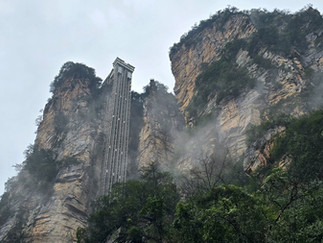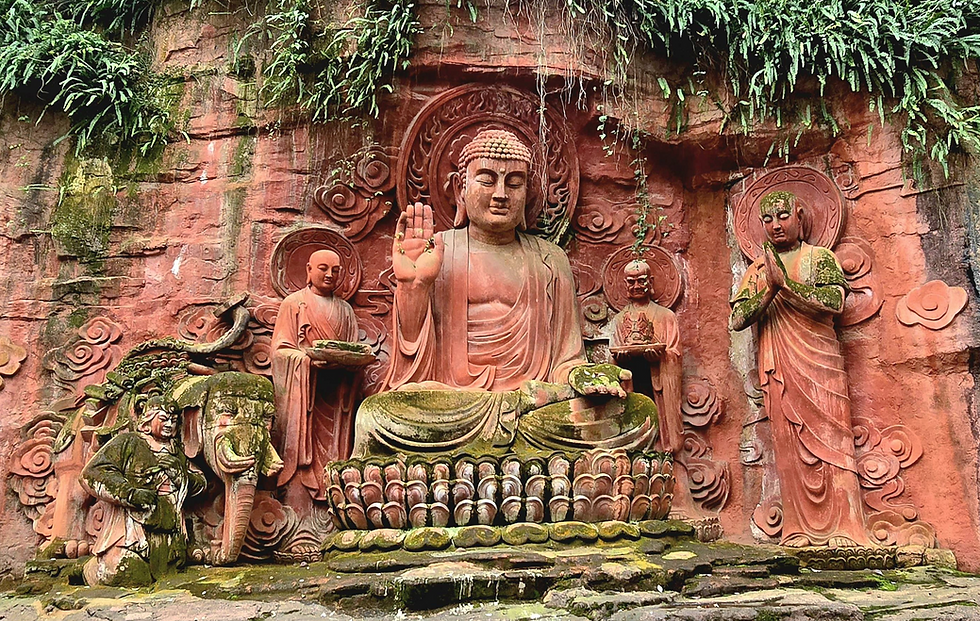Bailong Elevator - In the Shadow of Dragons
- Shannon
- Jul 14
- 4 min read
Rising like a gleaming spine along the raw sandstone cliffs of Zhangjiajie National Forest Park in China’s Hunan Province, the Bailong Elevator, also known as the "Hundred Dragons Elevator" is both a marvel of modern engineering and a looming monolith that stirs ancient fears. Piercing 326 metres into the sky, it is the tallest outdoor elevator in the world. Completed in 2002, its purpose was to ease environmental strain by transporting visitors more efficiently than hiking or vehicular access could allow. But its construction carved a permanent path through sacred stone, along what some locals whisper was once the flight path of a celestial guardian, a white dragon that once soared skyward to the heavens.

The Golden Whip stream runs through a gorge beneath the towering sandstone pillars of Zhangjiajie
The name "Bailong" translates to "White Dragon" and the legend it draws from casts a long shadow over its towering frame. The ancient myth tells of a dragon who guarded the lifeblood of the region, its jagged mountains and veined rivers. Its final ascent tore a path into the cliffs, splitting the earth with divine power. Where its body coiled in flight, the vertical drop was formed. This mythical rupture now hosts the elevator's glass shaft and locals say that disturbing the dragon’s resting path has unsettled more than just the mountain’s silence. On fog-laced mornings, some claim to see the dragon’s shape twisting through the mist, a spectral warning curled in the sky.

The region’s connection to folklore doesn’t end with dragons. Tianzi Mountain, one of Zhangjiajie's most iconic formations, carries a name that means “Son of Heaven.” It honours Xiang Dakun, a legendary Tujia chieftain who led a doomed rebellion against imperial forces during the late Yuan dynasty. After his death in battle, his spirit was said to have risen to the summit. Locals believe that the mountain’s jagged peaks resemble his figure standing watch, carved into the skyline by divine mourning. His presence lingers still. Winds howl through the peaks like war cries and red moss blooms at the base of certain stones, said to be the blood of his fallen warriors.
Zhangjiajie itself is home to more than 3000 quartzite sandstone pillars, many rising more than 200 meters high, silent titans formed over 350 million years. These skeletal spires, birthed by tectonic upheaval and endless erosion, resemble fingers reaching for the sky or perhaps trying to claw something back from it. These formations defy logic and balance, suspended like something the earth tried to forget. They have earned Zhangjiajie a UNESCO World Natural Heritage designation, yet even this title cannot dull the primordial eeriness of the landscape, where science and myth are often indistinguishable.
The elevator’s 90 second journey takes visitors into the belly of these legends, through a corridor of glass that reveals not only nature’s grandeur but its brooding silence. As the double-decker cars climb, it is not uncommon for the weather to shift without warning. Sudden fog rolls in, swallowing the cliffs whole. Locals believe this fog is the breath of ancestral spirits, stirred by the disruption of the sacred cliffs. Mechanical hums replace the whisper of the wind and the higher you rise, the more it feels like the veil between this world and another is thinning.

Known for its rich biodiversity, the national park is home to thousands of macaques. clouded leopards, Asiatic black bears, Chinese water deer and giant salamander
Zhangjiajie is shaped by the voices of its indigenous people, the Tujia, Miao and other ethnic minorities, whose oral histories and rituals are deeply entwined with the land. They view the park not just as geography but as a living realm where spirits, animals and ancestors reside. Many locals have resisted the commercialisation of the landscape, wary of what happens when ancient spirits are commodified for spectacle. Tales of tourists who have heard phantom chants or seen shadowy figures moving through the mist are dismissed by officials but among the villagers, they are accepted as warnings.
Despite the grandeur of its engineering, the Bailong Elevator is not merely a convenience, it is a scar cut into a living mythos. Its ascent may be swift, but it traverses more than vertical distance. It moves through layers of history, memory and superstition. In Zhangjiajie, every rock has a story and every climb carries echoes of those who rose and those who fell, long before the glass and steel touched the cliffs.

Location : Bailong Elevator, Zhangjiajie National Forest Park, Wulingyuan Scenic Area, Jundiping
How to get there : While there are 5 entry gates to to the Wulingyuan Scenic Area, most tourists chose to get in through Wulingyuan Ticket Station or the the Zhangjiajie forest gate, as they are the easiest to reach from Zhangjiajie downtown. Wulingyuan gate is the busier out of the two but is closer to all the attractions. From there, catch a free shuttle bus to the Bailong Elevator, it takes approximately 40 minutes for a one-way trip.
Attraction Info : The Bailong Elevator is open from March to November between 7am and 6pm (last enry at 5pm) or between December to February between 8am and 5pm (last entry at 4pm). Spring and Autumn offer the most stunning views. We did this as a fully inclusive full day tour for 460 yuan per person.
百龙电梯
A traditional Chinese-style wooden tower pagoda stands at the Wulingyuan entrance to the Zhangjiajie National Park
Thanks for reading about the Bailong Elevator - In the Shadow of Dragons. Check out more destinations here!


































